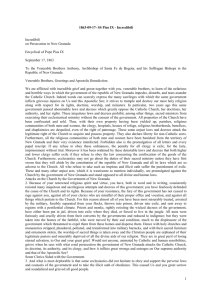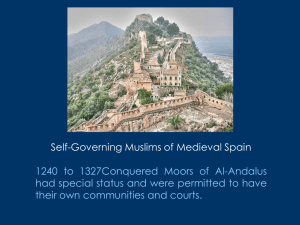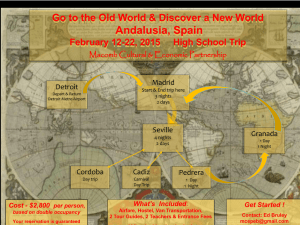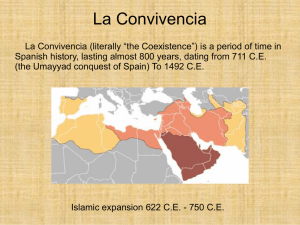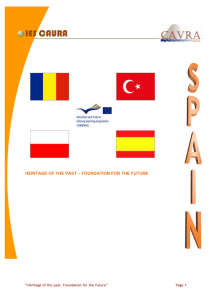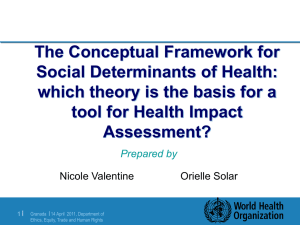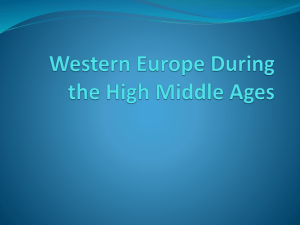handout - CLAS Users - University of Florida
advertisement
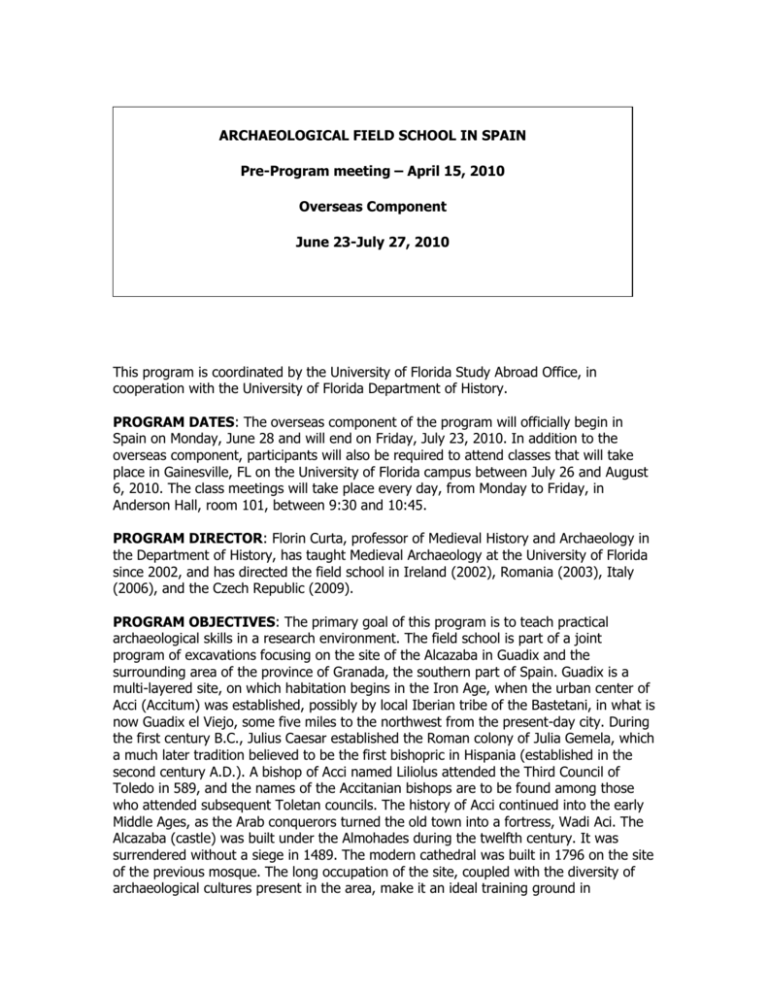
ARCHAEOLOGICAL FIELD SCHOOL IN SPAIN Pre-Program meeting – April 15, 2010 Overseas Component June 23-July 27, 2010 This program is coordinated by the University of Florida Study Abroad Office, in cooperation with the University of Florida Department of History. PROGRAM DATES: The overseas component of the program will officially begin in Spain on Monday, June 28 and will end on Friday, July 23, 2010. In addition to the overseas component, participants will also be required to attend classes that will take place in Gainesville, FL on the University of Florida campus between July 26 and August 6, 2010. The class meetings will take place every day, from Monday to Friday, in Anderson Hall, room 101, between 9:30 and 10:45. PROGRAM DIRECTOR: Florin Curta, professor of Medieval History and Archaeology in the Department of History, has taught Medieval Archaeology at the University of Florida since 2002, and has directed the field school in Ireland (2002), Romania (2003), Italy (2006), and the Czech Republic (2009). PROGRAM OBJECTIVES: The primary goal of this program is to teach practical archaeological skills in a research environment. The field school is part of a joint program of excavations focusing on the site of the Alcazaba in Guadix and the surrounding area of the province of Granada, the southern part of Spain. Guadix is a multi-layered site, on which habitation begins in the Iron Age, when the urban center of Acci (Accitum) was established, possibly by local Iberian tribe of the Bastetani, in what is now Guadix el Viejo, some five miles to the northwest from the present-day city. During the first century B.C., Julius Caesar established the Roman colony of Julia Gemela, which a much later tradition believed to be the first bishopric in Hispania (established in the second century A.D.). A bishop of Acci named Liliolus attended the Third Council of Toledo in 589, and the names of the Accitanian bishops are to be found among those who attended subsequent Toletan councils. The history of Acci continued into the early Middle Ages, as the Arab conquerors turned the old town into a fortress, Wadi Aci. The Alcazaba (castle) was built under the Almohades during the twelfth century. It was surrendered without a siege in 1489. The modern cathedral was built in 1796 on the site of the previous mosque. The long occupation of the site, coupled with the diversity of archaeological cultures present in the area, make it an ideal training ground in 2 archaeological methodology and provide ample evidence for introducing participants to the fascinating aspects of medieval archaeology. This field school is undertaken in conjunction with the with the research group Toponimia, Historia y Arqueologia del Reino de Granada at the University of Granada. Through participation in this program, participants will gain the following: a) an introduction and practical application of archaeological sampling and field methodology; b) field experience in archaeological survey techniques; c) field experience in archaeological excavation techniques; d) laboratory experience in conservation techniques; e) exposure to a broad range of artifacts (prehistoric through medieval); f) exposure to the problems of museum organization and studies in a European country; g) exposure to a new culture. HIGHLIGHTS: Muro Leccese is located slightly more than 35 miles east from Granada, the most important city in the province by that same name, less than 40 miles from the southern coast of Spain, east from Costa del Sol, and within short distances from Córdoba, Seville, Jaén, and Almería. The project team makes weekly excursions to these locales. Program participants and administrators expect to have an excellent rapport with the local community. THE SITE OF THE PROGRAM: Granada is a province of southern Spain, in the eastern part of the autonomous community of Andalusia. It is bordered by the provinces of Albacete, Murcia, Almería, Jaén, Córdoba, Málaga and the Mediterranean Sea. The tallest mountain in the Iberian Peninsula, Mulhacén, is located in Granada (11,413 feet. The northern and largest part of the Sierra Nevada National Park (in the Sierra Nevada mountain range) is in the Granada province. The history of Salento is equally rich. The Cueva de Las Ventanas, near the modern town of Piñar, some 30 miles north of Granada was inhabited by humans 25,000 years ago, while finds in the nearby Cueva de la Carigüela, discovered in 1951, indicate human presence 100,000 years ago. During the Bronze Age, the eastern part of the province was included into the very sophisticated civilization area of El Argar, with its Mediterranean influences of Mycenaean origin (18th to 14th century B.C.). The coast was visited by Phoenicians, who are said to be the founders of a number of small towns in Alpujarras (the region south of the Sierra Nevada), such as Salobreña and Almuñecar. By the time the Phoenicians reached the southern coast of Spain in ca. 800 B.C., the territory of the modern province of Granada was inhabited by several Celt-Iberian tribes, who established contacts with the newcomers on the coast. After the Phoenicians, the Greeks became interested in trade relations with the interior and even established a colony named Elibyrge in what is now the city of Granada. During the early decades of Roman rule within the province of Hispania, Elibyrge became Illebiris. During the Late Roman period, Illeberis became a Christian center, and one of the first council of the church n Hispania took place here in 300. The modern province of Granada was part of the kingdom of the Visigothic kings of Toledo, under whose rule the city of Illeberis flourished and grew economically, with a community of Jews established at the foot of the hill on which Alhambra now stands. 3 The Arab conquest of 711 and the creation of al-Andalus opened an era of great prosperity and blending of traditions and cultures. Granada became one of the richest and most dynamic cities of medieval Spain, brimming with traders, artisans, and even scientists. When the nearby Islamic kingdoms of Córdoba and Sevilla fell to Spain's 13th century Christian reconquista, Muslims seeking refuge gravitated to Granada, where the Islamic king Mohammed ibn Yusuf ibn Nasr had established an independent "Nasrid" emirate (officially a kingdom since 1238). The Nasrid emirs and kings were responsible for building most of the palaces in the Alhambra. Granada became a vassal state of the Christian kingdom of Castile for the next 250 years. The Nasrid emirs and kings paid tribute to the Christian kings and collaborated with them in their battle against rebellious Muslims under Christian rule. Initially the kingdom of Granada linked the commercial routes from Europe with those of the Maghreb. The kingdom constantly shrank due to repeated Castilian invasions, and at the end of the Granadan War, on January 2, 1492, the last Muslim leader, Muhammad XII, known as Boabdil to the Spanish, surrendered complete control of Granada, to Ferdinand and Isabella, the Catholic King and Queen of Spain. Guadix is in the province of Granada, in central Andalusia. A Roman colony established in 45 B.C. by Julius Caesar, it became an important fortification in the southern part of al-Andalus in the eighth century, and a provincial capital in the twelfth century. The Christian reconquista reached Guadix late in the fifteenth century, when the Alcazaba (castle) was surrendered without a siege to the army of the Catholic King and Queen of Spain. Guadix is on elevated plateau between the northern foothills of the Sierra Nevada mountain range between 2,950 and 3,280 feet above sea level. The city is home to a community of 20,975 inhabitants, more than half of whom have caves as houses (in the famous Barrio Troglodyte). Despite the proximity of the Mediterranean Sea, Guadix is located in a region of continental climate, with hot, dry summers (with an average high of 94 F) and cold winters. This region is full of history and is ideal for an archaeological expedition. For more information, please visit the municipality’s website at http://www.guadix.es/home.html. PROGRAM ACADEMIC CREDIT: For satisfactory participation in the program, participants will receive 6 semester hours of undergraduate or graduate credit in EUH4186: Medieval Archaeology Field Practicum. The course taken while participating in this program cannot be audited. PROGRAM ELIGIBILITY REQUIREMENTS: A brief essay outlining your background in history and/or archaeology, your interest in this program, as well as how the program will assist you academically and in the future Must be at least 18 years old Two letters of recommendation from professors (preferably University of Florida professors) with whom you took courses in the two past years or so 4 HEALTH CONSIDERATIONS: General good health is required for this rigorous program, which includes a fair amount of walking over frequently irregular surfaces. The weather will not be much hotter than it is in Florida, but endurance is a plus. HOTEL ACCOMODATIONS AND MEALS: From June 23 through July 27, participants will reside in the Hotel Comercio with two students per each room furnished with all necessary amenities, sharing bath and toilet facilities. The hotel is located in downtown Guadix, in a walking distance from the site. Meals are provided throughout the period of residency, with breakfast before work and evening meals including (but not restricted to) traditional Andalusian cuisine (try the zalamandroña!). Lunches are served on the site. Beverages (alcohol or soft drinks) are not included in the program cost. Participants are required to treat our hosts with respect. LAND TRANSPORTATION: In order to get to Guadix, you will need take the Alsina Graells bus from Granada. The trip lasts one hour and 15 minutes and costs €4.50 (the train is €6). For more details on schedules, see http://www.andalucia.com/travel/bus/granada.htm. In Guadix, the group will walk to and from the excavation site each day. AIR TRANSPORTATION: Individuals will be responsible for making their own air travel arrangements between the US and Granada, and for purchasing their tickets from a travel agent or airline of their choice. (Travel insurance is recommended). Participants should keep in mind that in order to arrive in Granada on June 27, they need to depart PROGRAM COST: The cost of the four-week program in Spain pays for the following cost related services: Two meals (breakfast and dinner) for every day, five days per week Program-related land transportation in Andalusia (weekly excursions) University of Florida tuition for six hours of undergraduate or graduate credit on June 26. ADDITIONAL COSTS TO PARTICIPANTS: Cost of acquiring an American passport; roundtrip airfare; meals during week-end excursions; purchases and travel of a personal nature. INTERNATIONAL STUDENT I.D. CARD: Participants have the option of purchasing an International Student Identity Card through the International Center Study Abroad office. Students may be able to obtain a reduction on airfare, culture site admission fees, and bus and train fares for free time pursuits. The International Student I.D. card also includes a limited health and accident insurance policy which is only valid outside the U.S. Students should however have a more comprehensive insurance plan to supplement the ID insurance. REQUIRED PERSONAL EFFECTS: Leather gloves, sunscreen, skin lotion, hat, insect-repellent, light rain gear Day pack and water bottle A line level, 6” metric ruler, clipboard, notebook, and pencils 5 A Marshalltown archaeology pointing trowel (blade Size: 4-1/2" x 2-1/4") Optional equipment includes a camera, binoculars, and bathing suit. WORK SCHEDULE: Work will be five days a week, eight hours days, starting at 8 am Participants will aid primarily in the excavation of residential units in the Alcazaba (castle) Participants will move dirt and stone, screen for artifacts, and make detailed maps Participants will also be responsible for cleaning and cataloging artifacts After excavation is complete, all holes will be back-filled All tasks will be rotated among the participants, so everyone gets a chance to learn On a rotation basis, all participants will have the opportunity to work in conservation laboratories Saturdays and Sundays are usually spent on field trips to various sites in Andalusia

